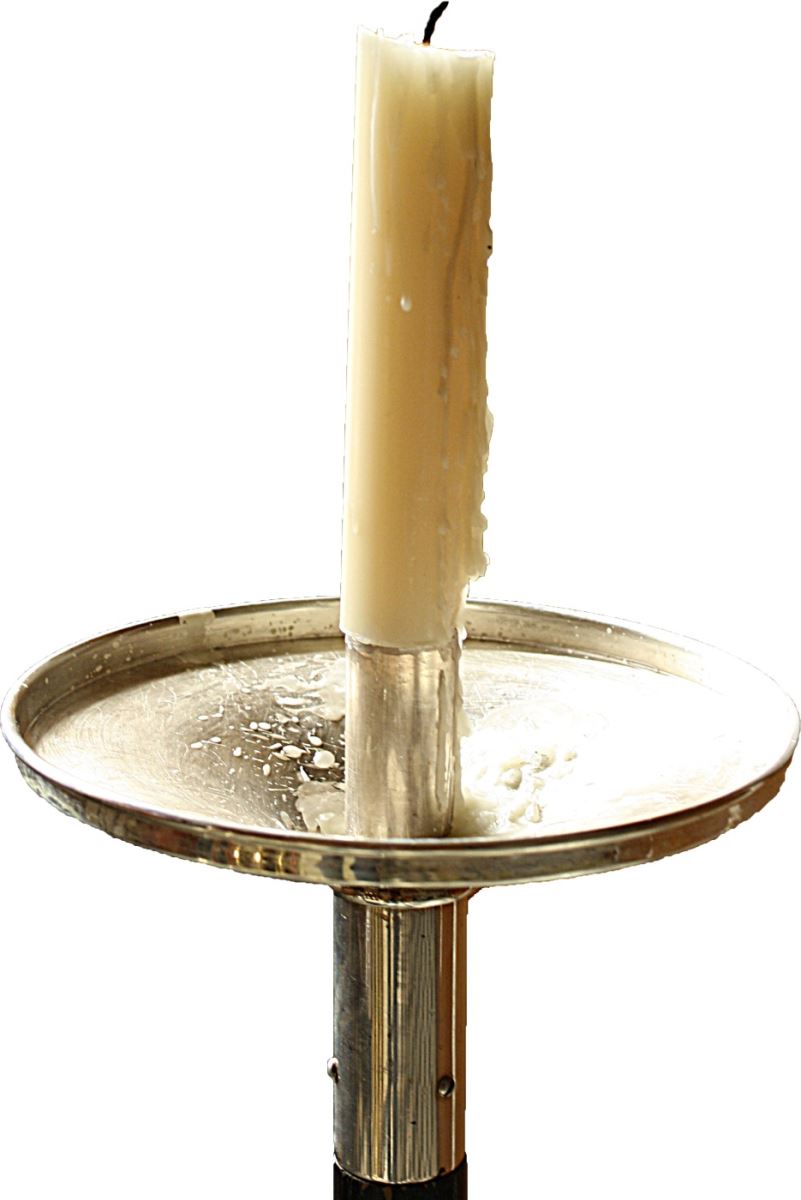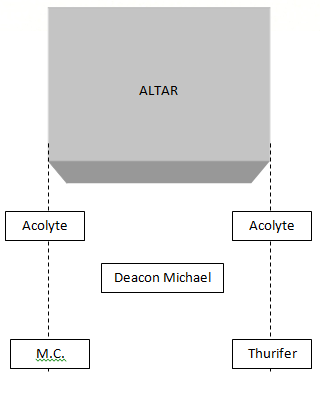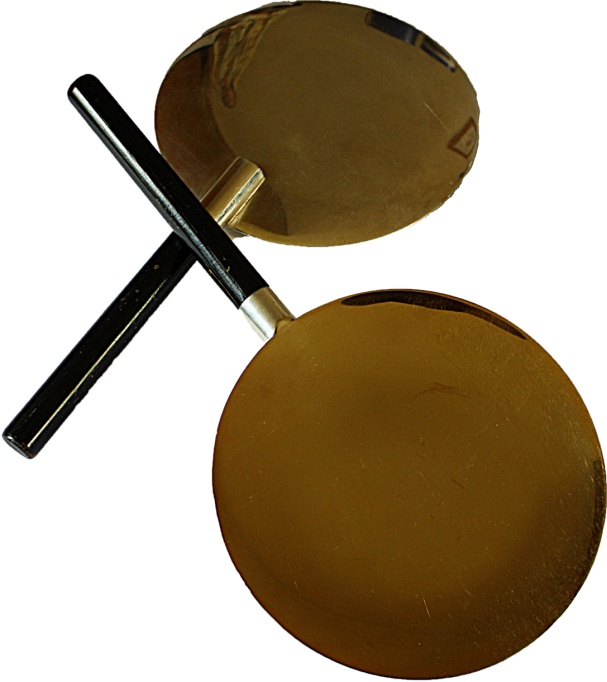 REMEMBER – acolytes work as a pair. Always be aware of what your partner is doing. Be ready to respond if necessary. It is useful to imagine an invisible plank joining you together.
REMEMBER – acolytes work as a pair. Always be aware of what your partner is doing. Be ready to respond if necessary. It is useful to imagine an invisible plank joining you together.
ENTRANCE PROCESSION – line up in the church porch on either side of the cross bearer. If incense is not being used you will lead the procession. When the choir/congregation start singing the gathering hymn (or on a signal from the Master of Ceremonies) move into the church. If you are leading the procession everyone else will take their pace from you. Walk at a normal pace – it is not a race or a crawl. When you reach the sanctuary place your candles in the holders on either side of the credence table. There is no need to bow when you enter the sanctuary and definitely do not try to genuflect. Remain in your places until the Gospel acclamation.
GOSPEL – as soon as the Gospel acclamation “Alleluia, alleluia ...” begins pick up your candles and stand in front of the corners of the altar, facing it. Wait there until Deacon Michael has received his blessing, picked up the Book of the Gospels and come to join you. Then bow to the altar and accompany him to the ambo standing either side and slightly behind him during the proclamation of the Gospel. Turn inwards so that you are facing each other. Try to keep your candles level and roughly at eye level – it looks neater. If during a long Gospel you need to rest your candle on the floor do so. Be aware if your partner does this and do the same. The procedure is the same if Deacon Michael is away and Father Paul or another priest proclaims the Gospel except that he does not ask for a blessing. At the end of the Gospel return to the front of the altar, bow to it and return to your places either side of the credence table.
GOSPEL (IF INCENSE IS USED) - as soon as the Gospel acclamation “Alleluia, alleluia ...” begins pick up your candles and stand in front of the altar as described above. Wait there while Father Paul puts incense in the thurible and blesses it. When he has done this, while Deacon Michael is receiving his blessing, the thurifer and Master of Ceremonies will come and stand immediately behind you. Once he has picked up the Book of the Gospels, Deacon Michael will come and stand in the middle of the group as shown below. Everyone then bows to the altar.
After you have bowed to the altar accompany the Book of the Gospels to the ambo standing as described above – with one difference. Whoever is the acolyte furthest away from the pillar needs to stand a pace or two back to allow the Master of Ceremonies to hand the thurible to Deacon Michael. Once the Book of the Gospels has been incensed and the thurible handed back to the thurifer return to your normal position. After the Gospel return to your position by the credence table as described above.

PROCESSION OF THE GIFTS – as soon as Father Paul and Deacon Michael get up and move forward to receive the bread, wine and water, one acolyte joins them at the foot of the sanctuary steps. Take whatever Father Paul gives you, bow with everyone else to the people who have brought the gifts and take whatever you are carrying to the credence table.
PREPARATION OF THE CHALICES – at the credence table remove the stopper from the bottle and, if it has a handle, turn it so that the handle is away from you. This makes it easier for Deacon Michael to take and to pour the wine into the chalices. With your partner alongside you approach the altar with the water and wine handing them to him as he needs them. Remember – always hand whatever you are carrying to Father Paul or Deacon Michael. They are praying the Mass and do not ‘reach’ to take anything. When Deacon Michael has filled the chalices and handed the water and wine back to you bow to him, turn and return to the credence table.
(If incense is being used this will be done now.)
WASHING THE PRIEST’S FINGERS – this dates back to the early church when the gifts brought to the altar used to be produce of all kinds and the priest’s hands would get dirty receiving them. Now, as the prayer that the priest says, “Lord, wash away my iniquity, cleanse me from my sin.” it represents a desire for inner purity and reminds the priest of his unworthiness to celebrate the action of the Mass. Pick up the lavabo bowl and towel and approach the altar. If you are holding the towel open it so that Father Paul can use it easily. After he had washed his fingers and dried them bow to him and return to the credence table. Fold the towel up neatly.
 RINGING THE BELL - Apart from announcing the start of Mass the bell is rung[1] four times during the celebration of the Mass – to tell people that something important is happening. For the same reason the bell in the tower is rung at the Consecration.
RINGING THE BELL - Apart from announcing the start of Mass the bell is rung[1] four times during the celebration of the Mass – to tell people that something important is happening. For the same reason the bell in the tower is rung at the Consecration.
1. At the epiklesis – when Fr. Paul holds his hands over the bread and wine. The ‘laying on of hands’ goes back to the Old Testament and is still used in the church today. Both Fr. Paul and Deacon Michael were ordained by a bishop laying his hands on their heads. During the Mass it represents the priest, standing at the altar in the person of Jesus Christ, invoking the power of the Holy Spirit to change the gifts of bread and wine into the Body and Blood of Our Lord. (Be careful – during the First Eucharistic Prayer, the priest makes the sign of the cross over the gifts with his right hand before the epiklesis. Do not ring the bell.[1])
2. At the elevation of the consecrated host – to underline that this is now no longer bread but the Body of the Lord.
3. At the elevation of the chalice after the consecration – similarly to underline that this now no longer contains wine but the Precious Blood of Jesus.
4. When Fr. Paul takes Holy Communion and drinks the Precious Blood from the chalice.
“If the sound is pleasant and servers are trained to use it reverently and sensibly, the bell enhances and accentuates the solemn moments of the sacred action.” (Elloitt. 113)
To ring the bell “reverently and sensibly” for 1 and 4 above quietly say “one thousand” while ringing the bell then stop. For the two elevations (2 and 3) say “one thousand, two thousand, three thousand” while ringing the bell then stop.
 HOLY COMMUNION – after you have received Holy Communion pick up one of the Communion plates and join whoever is distributing the hosts at the sanctuary steps. Stand to one side so that you can easily hold the plate under the hands or chin of the person receiving Holy Communion. Be aware if the person approaching is going to receive in the hand, or on the tongue or is just coming for a blessing and adjust the position of the plate accordingly. The purpose of the plate is to catch any dropped hosts to stop them from falling on the floor - these are still the Body of Jesus Christ. Therefore try to keep it horizontal at all times. Never raise or lower then so that they are vertical. When Holy Communion is over return to your place on either side of the credence table. Place the communion plates so that they are face up on the credence table. If, when tioy are clearing up after Mass, you take the communion plates into the sacristy, always carry them so that they are horizontal.
HOLY COMMUNION – after you have received Holy Communion pick up one of the Communion plates and join whoever is distributing the hosts at the sanctuary steps. Stand to one side so that you can easily hold the plate under the hands or chin of the person receiving Holy Communion. Be aware if the person approaching is going to receive in the hand, or on the tongue or is just coming for a blessing and adjust the position of the plate accordingly. The purpose of the plate is to catch any dropped hosts to stop them from falling on the floor - these are still the Body of Jesus Christ. Therefore try to keep it horizontal at all times. Never raise or lower then so that they are vertical. When Holy Communion is over return to your place on either side of the credence table. Place the communion plates so that they are face up on the credence table. If, when tioy are clearing up after Mass, you take the communion plates into the sacristy, always carry them so that they are horizontal.
CONCLUDING PROCESSION – keep your eye on the M.C. and crucifer (cross bearer). As soon as he/she picks up the cress pick up your candles and join him/her in the main body of the church. How far back you will stand will depend on the number of altar servers and clergy present. Turn and face the altar. When the rest of the sanctuary party have joined you and have bowed to the altar and genuflected to the tabernacle turn and process out keeping the pace steady.
[1] Do not worry if you do. You are not the first altar server to get caught out and you will not be the last!
[1] Except at the Mass of the Last Supper when the bells are rung at the Gloria ad then remain silent until the Easter Vigil.